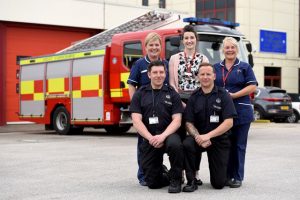The Atlas of Shared Learning
Case study
Falls Prevention Nurses lead collaborative falls service improvement with West Yorkshire Fire and Rescue Service
 Leading change
Leading change
The Falls Prevention Nurses at Bradford District Care NHS Foundation Trust (BDCFT) have led change by working in partnership and collaboratively on falls prevention with the West Yorkshire Fire and Rescue Service (WYFRS).
Where to look
The Falls Prevention Team at BDCFT provides advice and support to other services and organisations across Bradford and Airedale. The team identified unwarranted variation and missed opportunities to enhance their falls prevention work. This led them to begin offering falls awareness training for WYFRS, supporting them to start providing falls prevention advice and information to their service users as part of their day to day work and linking with their ‘Safe and Well’ strategy. This is a safer community’s strategy launched nationally by the fire service looking at key areas for preventative work in the community. WYFRS chose falls prevention as one of their focus topics and with support from nursing leadership.
The BDCFT nurses recognised that the fire service is well-placed to support prevention practice and population health, notably in the reduction of fire incidence and associated deaths. They are routinely working with ‘vulnerable’ people that may be at risk of falls and who are not receiving any support or intervention to minimise this. The team identified that through collaborative working, the fire fighters could develop an additional skill set that could improve local people’s outcome in relation to falls.
What to change
Before the change, referral pathways from WYFRS into falls services were not in place, and home fire safety assessments were predominantly focused around fire prevention. A pilot was initiated and it was agreed that following training a falls screening tool would be incorporated within the home fire safety assessment form to identify individuals at risk of falling. If indicated, fire fighters would then be able to refer onto appropriate nursing service for a multifactorial falls assessment.
How to change
Fire crews involved in the pilot received training from the Falls Prevention Team Leader for BDCFT. The falls screening tool was developed as part of a task and finish group involving health and social care professionals across different organisations within the area, also including from WYFRS. A feedback workshop was held and received positive responses from both fire fighters and community nurses who were involved.
As a result of this and other successful pilots across West Yorkshire, the training has now been launched and delivered across Bradford and Airedale with members of the falls prevention team involved in the development of the regional training programme. The training has been delivered to all fire fighters across the district by the Falls Prevention Nurse for BDCFT and a training officer for WYFRS. The training has given fire fighters the skills to assess individuals who may be at risk of falling, give basic advice and relate this to their fire prevention work.
Adding value
Better outcomes – This is an on-going programme and the nurse leaders are yet to receive figures and feedback regarding referrals received from the district nursing services. However, there were 7 referrals in June 2018; of these, 4 needed a full assessment and the remaining 3 were either already known to the team, or declined assessment. Crucially, the 4 patients needing assessment would have remained unknown to the service were it not for this new programme. This programme identifies people at risk of falls so that appropriate interventions can be put in place to prevent a possible fall, life-limiting injury or hospital admissions. A case study from the pilot scheme saw an 85 year old female patient assessed by district nurses 2 days following a referral from the fire service. She was identified as having postural hypotension and referred to her GP for a medication review and monitoring which is extremely positive.
Better experience – The feedback workshop held following the pilot involved project leads, 6 nursing staff and the on-duty watch of fire fighters. Evaluation forms have also been given to each fire fighter who has received the falls training across Bradford and Airedale; feedback has been mainly positive with crews embracing the concept of “safe and well”. Evaluations have also identified further ways to improve the programme and the nurse leaders are currently in the process of using these to develop pathways and systems further. This includes embracing secure electronic referrals in the future.
Better use of resources – The nurse leaders implementing this change continue to work in partnership with WYFRS and a cascaded training approach is now in place to ensure effective use of resources. The nurse leaders continue to monitor referral rates from fire services to assess the impact of the programme on services and to ensure referrals received are appropriate.
Challenges and lessons learnt for implementation
The importance of partnership, joined up working cannot be underestimated in improving patient care. Effective communication between organisations has been paramount in ensuring the success of this programme.
A prominent challenge throughout this work has been the referral process and setting up a secure email for a referral route.
Effective communication and regular meetings with partner organisations throughout the initiative, helps to ensure the best outcomes. To promote motivation and engagement with the new ways of working and to ensure continued monitoring and development it is important to involve teams on the frontline in decision making and feedback
Staff understanding is also key, especially in the initial phases of launch. The training provided to fire fighters supported this by ensuring they understood the importance of falls prevention and have the skills to go onto embrace the improvements to practice.
Find out more
For more information, contact:
- Sharon Bond, Falls Prevention Team Leader, Sharon.bond@bdct.nhs.uk
- Rachel Morris, Falls Prevention Nurse, Rachel.morris@bdct.nhs.uk
